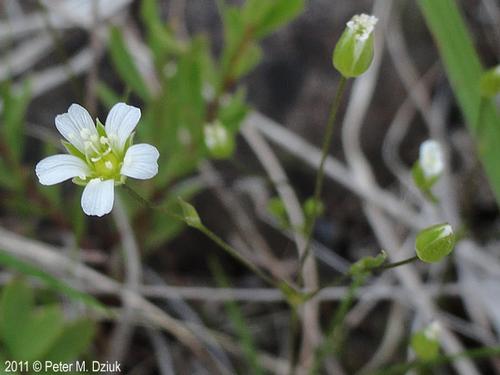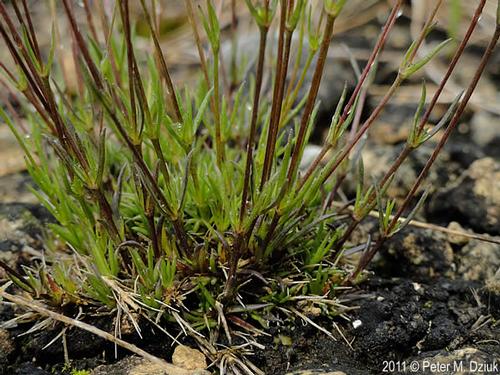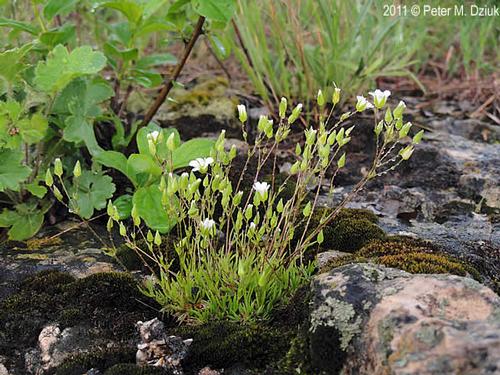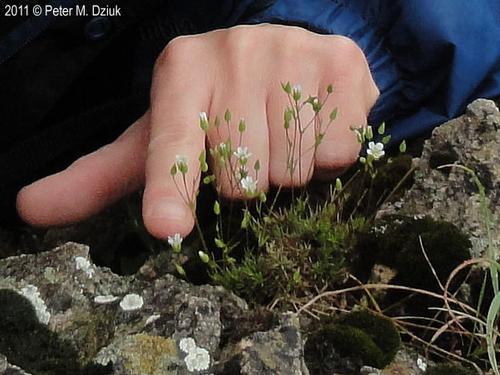Plants and Animals
Minuartia dawsonensis Rock sandwort
Key Characteristics
A small opposite-leaved perennial forb, generally 8–15 mm (0.3–0.6 in) tall. Its five white petals are about as long as the sepals. Seeds are 0.6–0.7 mm (0.02–0.03 in) wide. In Michigan, its range is restricted to the Upper Peninsula and Isle Royale.
It can be distinguished from others in the Caryophyllaceae/pink family by the following traits: glabrous (i.e., hairless) on all parts, presence of stipules, linear leaves with a bristly tip, lack of umbels, three styles rather than four to five, free (unfused) sepals, and fruit (a capsule) with three rather than six teeth after splitting open. To distinguish this species from our other rock sandwort (M. michauxii), look for equally long petals and sepals, smaller seeds, and smaller size overall.
Status and Rank
US Status: No Status/Not Listed
State Status: T - Threatened (legally protected)
Global Rank: G5 - Secure
State Rank: SNR - Not ranked
Occurrences
| County | Number of Occurrences | Year Last Observed |
|---|---|---|
| Delta | 1 | 2021 |
Information is summarized from MNFI's database of rare species and community occurrences. Data may not reflect true distribution since much of the state has not been thoroughly surveyed.
Habitat
This is a species of northern North America. Known occurrences in Michigan are from a very few instances in Mackinac, Delta, Keewenaw, and Schoolcraft Counties, where it has been documented in sand dunes, juniper heaths, and rocky shores and rock crevices on or near the Great Lakes. In nearby states and provinces, this species is known from crevices and accumulations of shallow organic matter within horizontal stretches of generally calcareous exposed bedrock (sandstone, limestone, and dolomite). It has also been documented from exposed sand and gravel and rarely from upland sand prairies. It seems to be consistently found in dry, sunny, open areas.
Natural Community Types
For each species, lists of natural communities were derived from review of the nearly 6,500 element occurrences in the MNFI database, in addition to herbarium label data for some taxa. In most cases, at least one specimen record exists for each listed natural community. For certain taxa, especially poorly collected or extirpated species of prairie and savanna habitats, natural community lists were derived from inferences from collection sites and habitat preferences in immediately adjacent states (particularly Indiana and Illinois). Natural communities are not listed for those species documented only from altered or ruderal habitats in Michigan, especially for taxa that occur in a variety of habitats outside of the state.
Natural communities are not listed in order of frequency of occurrence, but are rather derived from the full set of natural communities, organized by Ecological Group. In many cases, the general habitat descriptions should provide greater clarity and direction to the surveyor. In future versions of the Rare Species Explorer, we hope to incorporate natural community fidelity ranks for each taxon.
Associated Plants
In Michigan, data are so sparse that it has been documented only with bearberry (Arctostaphylos uva-ursi), rush (Juncus balticus), and alpine bluegrass (Poa alpina). In nearby states and provinces, it has been documented with wild columbine (Aquilegia canadensis), sand cress (Arabis lyrata), wild wormwood (Artemisia campestris), paper birch (Betula papyrifera), side-oats grama (Bouteloua curtipendula), sedge (Carex eburnea), eastern red cedar (Juniperus virginiana), smooth cliff-brake (Pellaea glabella), little bluestem (Schizachyrium scoparium), sand club moss (Selaginella ruspestris), and hairy goldenrod (Solidago hispida).
Management Recommendations
This species requires dry open conditions in rock, gravel, or sand. It would benefit from invasive species treatment. In some settings, it would likely benefit from prescribed fire and brush removal during the dormant season. This species appears to be intolerant of grazing. This plant is so rare in Michigan that substantial effort should be made to protect it, including the rerouting of recreational activities.
Survey Methods
Random meander search covers areas that appear likely to have rare taxa, based on habitat and the judgment of the investigator.
-
Meander Search
-
Survey Period: From first week of June to fourth week of August
-
References
Survey References
- Elzinga, C.L., D.W. Salzer, and J.W. Willoughby. 1998. Measuring and Monitoring Plant Populations. The Nature Conservancy and Bureau of Land Management, Denver. BLM Technical Reference 1730-1. 477pp.
- Goff, G.F., G.A. Dawson, and J.J. Rochow. 1982. Site examination for Threatened and Endangered plant species. Environmental Management 6(4): 307-316
- Nelson, J.R. 1984. Rare Plant Field Survey Guidelines. In: J.P. Smith and R. York. Inventory of rare and endangered vascular plants of California. 3rd Ed. California Native Plant Society, Berkeley. 174pp.
- Nelson, J.R. 1986. Rare Plant Surveys: Techniques For Impact Assessment. Natural Areas Journal 5(3):18-30.
- Nelson, J.R. 1987. Rare Plant Surveys: Techniques for Impact Assessment. In: Conservation and management of rare and endangered plants. Ed. T.S. Elias. California Native Plant Society, Sacramento. 8pp.
Technical References
- Minnesota Department of Natural Resources. 2024. Rare Species Guide: Minuartia dawsonensis. <https://www.dnr.state.mn.us/rsg/profile.html?action=elementDetail&selectedElement=PDCAR0G070>. Accessed 14 October 2024.
- NatureServe. 2024. NatureServe Network Biodiversity Location Data accessed through NatureServe Explorer Web. Accessed 14 October 2024.
- Reznicek, A. A., E. G. Voss, and B. S. Walters. 2024. Michigan Flora Online. University of Michigan. <http://michiganflora.net>. Accessed 14 October 2024.
- Ruhfel, B. R. 2024. University of Michigan Herbarium. Personal communication.
- Wilhelm, G. and L. Rericha. 2017. Flora of the Chicago Region: A Floristic and Ecological Synthesis. Indiana Academy of Science, Indianapolis, IN.
- Wisonsin Department of Natural Resources. 2024. Rock Stitchwort (Minuartia dawsonensis). <https://apps.dnr.wi.gov/biodiversity/Home/detail/plants/8741>. Accessed 14 October 2024.





